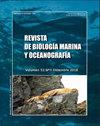Indicadores de sustentabilidad para la pesquería de curvina golfina Cynoscion othonopterus en el Alto Golfo de California
IF 0.5
4区 生物学
Q4 MARINE & FRESHWATER BIOLOGY
引用次数: 6
Abstract
espanolResumen: El Alto Golfo de California y Delta del Rio Colorado es un area que se encuentra inmersa en un conflicto ecologico, economico, politico y social debido a la pesca ilegal de totoaba Totoaba macdonaldi y la posible extincion de vaquita marina Phocoena sinus. Esto ultimo ha provocado el cierre de todas las pesquerias en la region salvo la de curvina golfina Cynoscion othonopterus la cual es la unica especie con permiso de explotacion. Por lo tanto, el objetivo principal fue evaluar el estado de salud de la pesqueria mediante los indicadores de sustentabilidad de Froese en el Alto Golfo de California durante las temporadas de pesca 2008, 2013, 2014 y 2015. Los resultados mostraron que la produccion anual de curvina golfina presenta fluctuaciones, resaltando el periodo 2012-2016, donde las capturas totales con excepcion de 2014, sobrepasaron la cuota de captura establecida por el Instituto Nacional de la Pesca. La longitud de madurez para los anos estudiados fueron: 2008= L50: 502 mm (IC= 490-514 mm), 2013= L50: 559 mm (IC= 544-576 mm), 2014= L50: 499 mm (IC= 476-518 mm), y 2015= L50: 480 mm (IC= 445-510 mm). Con base en los indicadores de sustentabilidad, se demuestra que la pesqueria de curvina golfina esta dirigida hacia los organismos de mayor longitud (mega-reproductores). Se concluye que actualmente la curvina golfina manifiesta problemas de sobreexplotacion y por ende su aprovechamiento no es sustentable. Esto sugiere la necesidad realizar ajustes y actualizaciones a las actuales medidas de manejo. EnglishAbstract: The Upper Gulf of California and Colorado River Delta is a zone which is immersed in an ecological, economic, political and social conflict. That is because of the Totoaba Totoaba macdonaldi illegal fishing and the Vaquita Phocoena sinus potential extinction. This issue has driven to ban all the region's fisheries with the exception of the Gulf corvina Cynoscion othonopterus which is the only of the finfish species with operating license. Therefore, the main objetive was to evaluate the fishery's health condition through the Froese sustainability indicators in Upper Gulf of California during 2008, 2013, 2014 and 2015 fishing seasons. The results showed that the Gulf corvina annual production ratio showed fluctuations, highlighting in the 2012-2016 period, when the whole fishing captures with the exception of 2014, surpassed the established quota by the National Institute of Fishery (Instituto Nacional de Pesca). The size-at-maturity were: 2008= L50: 502 mm (IC= 490-514 mm), 2013= L50: 559 mm (IC= 544-576 mm), 2014= L50: 499 mm (IC= 476-518 mm), and 2015= L50: 480 mm (IC= 445-510 mm). Based on the sustainability indicators, it is demonstrated that the Gulf corvina fishery is directed towards the organisms of greater length (mega-spawners). Finally it is concluded that Gulf corvina currently shows problems of over-exploitation and therefore its exploitation is not sustainable. This suggests the need to make adjustments and updates to current management measures.上加利福尼亚湾Curvina Golfina Cynossion othonopterus渔业的可持续性指标
摘要:上加利福尼亚湾和科罗拉多河三角洲是一个生态、经济、政治和社会冲突的地区,原因是非法捕捞totoaba macdonaldi和小头鼠海豚Phocoena sinus可能灭绝。这导致该地区所有渔场关闭,除了curina golfina Cynoscion othonopterus,这是唯一获得开发许可的物种。因此,主要目标是利用Froese可持续性指标评估2008年、2013年、2014年和2015年上加利福尼亚湾捕鱼季节的渔业健康状况。在本研究中,我们分析了不同物种之间的渔获量差异,并分析了不同物种之间的渔获量差异,以确定不同物种之间的渔获量差异。2008年= L50: 502 mm (IC= 490-514 mm), 2013年= L50: 559 mm (IC= 544-576 mm), 2014年= L50: 499 mm (IC= 476-518 mm), 2015年= L50: 480 mm (IC= 445-510 mm)。在本研究中,我们分析了不同物种之间的关系,并确定了不同物种之间的关系。本研究的目的是确定曲率高尔菲纳湾目前的开采情况,并确定其开采的可持续性。这表明需要对现有的管理措施进行调整和更新。= =地理= =根据美国人口普查局的数据,该县的总面积为,其中土地和(1.)水。= =地理= =根据美国人口普查,该县的总面积为,其中土地和(0.964平方公里)水。= =地理= =根据美国人口普查,该县的总面积为,其中土地和(3.064平方公里)水。因此,主要目标是通过2008年、2013年、2014年和2015年捕鱼季节加州上湾的霜冻可持续性指标来评估渔业的健康状况。结果显示,海湾黄花鱼年产量比出现波动,在2012-2016年期间最为突出,当时除2014年以外的所有渔获量都超过了国家渔业研究所规定的配额。成熟尺寸为:2008= L50: 502 mm (IC= 490-514 mm), 2013= L50: 559 mm (IC= 544-576 mm), 2014= L50: 499 mm (IC= 476-518 mm), 2015= L50: 480 mm (IC= 445-510 mm)。根据可持续性指标,表明海湾黄花鱼渔业的目标是较大的生物(大型产卵者)。最后得出的结论是,海湾黄花鱼目前存在过度开发的问题,因此其开发是不可持续的。这表明需要对目前的管理措施作出调整和更新。
本文章由计算机程序翻译,如有差异,请以英文原文为准。
求助全文
约1分钟内获得全文
求助全文
来源期刊
CiteScore
0.70
自引率
0.00%
发文量
41
审稿时长
12 months
期刊介绍:
Publicar desde una perspectiva científica, artículos originales, decididos por un proceso de revisión por pares, invitando a expertos de reconocido prestigio en el área. Los trabajos publicados se caracterizarán por su solidez teórica-metodológica, actualidad y relevancia para las ciencias marinas.
Se reciben trabajos inéditos derivados de la investigación científica realizada en ambientes marinos y estuarios, en formato de Revisión, Artículos, Notas Científicas, y Obituarios en las siguientes disciplinas::
Biología-Ecología marina
Oceanografía física, química y biológica
Contaminación marina
Geología marina
Sistemática, Faunística y Biogeografía Marina
Manejo Costero
Acuicultura marina
Pesquería marina.

 求助内容:
求助内容: 应助结果提醒方式:
应助结果提醒方式:


